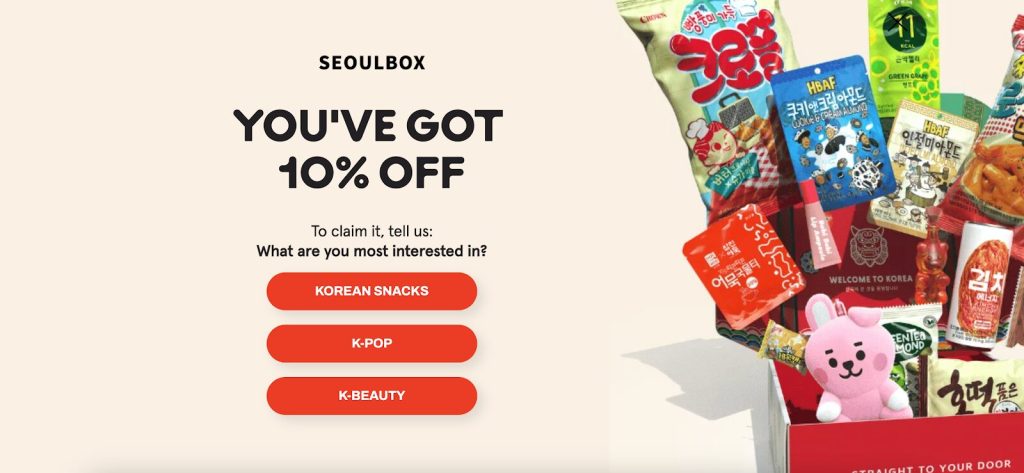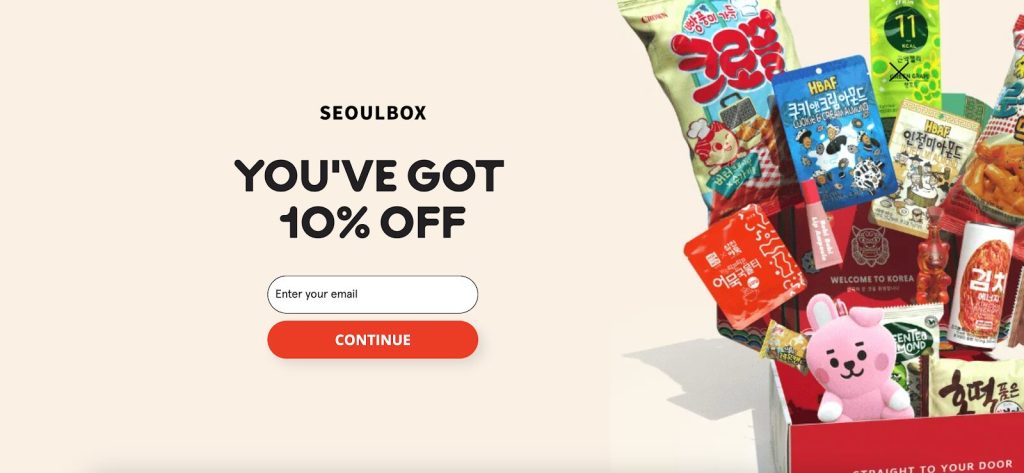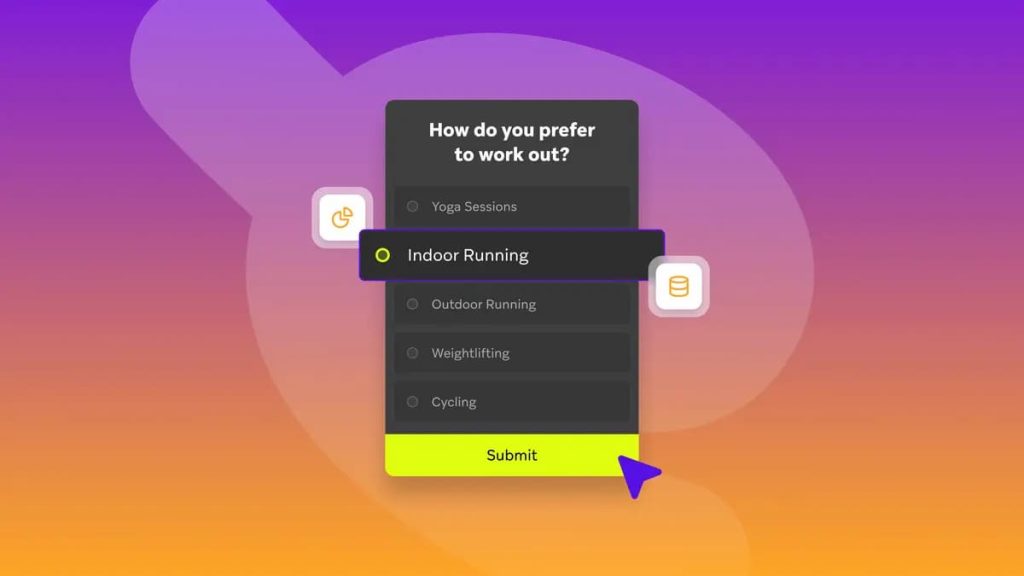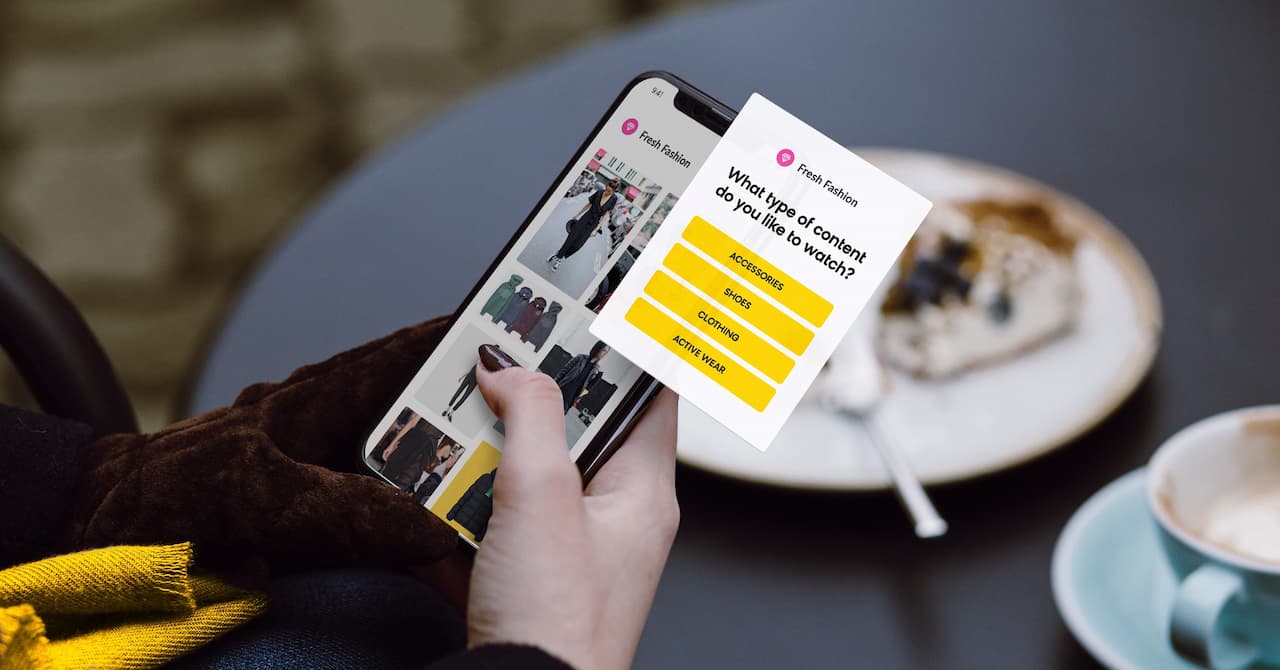Zero-party data (ZPD) is information customers intentionally and proactively share with you—preferences, needs, intentions, and context. Because it’s volunteered with consent (not inferred or tracked), it’s the most privacy-friendly and trustworthy data you can use to personalize experiences, deepen relationships, and lift conversions. Collect it through value-rich moments (quizzes, multi-step pop-ups, preference centers, post-purchase surveys, chat/SMS, loyalty), store it cleanly, and activate it across your lifecycle flows and campaigns.
In this form, Seoulbox seamlessly blends a micro-commitment with zero-party data collection. This allows the brand to segment their audience based on preferences and send more personalized offers.


Zero-party data is your 2025 edge. When visitors tell you who they are and what they want—needs, use-case, budget, preferences—you have a better understanding of your audience and what they care about. Capturing those signals at signup enables you to tailor your welcome series from day one: segment the audience, adjust subject lines and offers, swap product recs, and set the right cadence. The result is sharper relevance, higher engagement and deliverability, and faster first-purchase conversions.
What is Zero-Party Data?
Zero-party data is data a customer deliberately gives you in exchange for a clear benefit. These include:
- Directly provided personal information: Customers may share their first name, birthday, preferred sizes, location or favorite colors to receive personalized recommendations.
- Purchase intentions & timing: gift vs. self, occasion/date, replenishment cadence, when they want to buy.
- Communication preferences: Users specifying how they want to be contacted (e.g., email, SMS) and how often.
- Preferences: sizes, colors, flavors, styles, skin/hair type, dietary needs, materials, price ceiling.
- Interests and hobbies: Customers voluntarily providing details about their interests and activities for tailored experiences.
- Account settings: Information set by a user within their profile, such as preferred language or content types.
- Constraints: budget band, allergies, shipping urgency, room size (for home goods), pet breed/age.
- Feedback and ratings: Customer reviews or ratings for products and services, which provide direct feedback on their experiences.
- Wish lists: Items that customers save to a wish list or “favorites” list, indicating their preferences and potential purchases
How it differs from other data
- First-party data: Observed by you (site events, purchases, clicks).
- Second-party data: Someone else’s first-party data you obtain directly (partnerships).
- Third-party data: Aggregated/inferred from outside your ecosystem (cookies, brokers).
ZPD is declared (not inferred), consented, and actionable—perfect for ethical personalization.
Why Zero-Party Data Is More Privacy-Protected (and Trustworthy)
- Explicit consent: Customers choose what to share and why.
- Transparent value exchange: You clearly state what they get back (better recommendations, early access, tailored content).
- No cross-site tracking: No shadowy cookies or device graphs; trust increases, “creepy factor” drops.
- User control: Easy to edit preferences or withdraw consent (via preference centers).
- Higher accuracy: Self-reported > guesswork. Less waste, better relevance.
Key characteristics: Voluntary, contextual, specific, revocable, identity-resolved, and immediately useful.
Why It Matters: Engagement, Deliverability, Conversions
- Relevance → opens & clicks: People engage with what reflects their stated needs.
- Better deliverability: Higher interaction improves sender reputation and inbox placement.
- Lower CAC wastage: Send fewer irrelevant messages; convert traffic you already paid for.
- Faster path to value: Get to the right product/story faster; reduce bounce and hesitation.
- Deeper loyalty: Transparent, helpful personalization builds durable trust.
The Best (Proven) Ways to Collect Zero-Party Data
Zero-party data can be collected in many ways, but the key is making it feel natural and valuable for the user. If the process feels forced or overwhelming, people won’t share their information. Instead, use simple, engaging experiences that clearly show the benefit of sharing data. Treat it as a fair exchange—personal information for personalized value—and you’ll succeed in collecting zero-party data.

Low-Friction Zero-Party Data Collection
Best for early funnel engagement when you want to keep signups smooth and fast.
- Interactive Signup Forms: Add simple optional fields directly on your signup forms asking about their preferences, so you can personalize their experience right off the bat.
- Polls & Q&A Sessions: Use quick polls or live Q&As on social media to gather lightweight insights.
- Chatbots & Live Chat: Ask a few contextual questions in real time to personalize recommendations.
- User Profiles (Lite): Encourage customers to add a few basics like name, birthday, or style preference without requiring too much upfront effort.
High-Value Exchange Zero-Party Data Collection
Best for when customers are already engaged and willing to trade more details for value.
- Surveys: Use style finders, product match tools, or satisfaction surveys that deliver tailored results. Avoid generic surveys—make them relevant to the user’s journey. For example, if they just made a purchase, ask specifically about that experience.
- Quizzes: Offer high-value tools like skincare match quizzes or ROI calculators in exchange for preferences. People love interactive quizzes that reveal something about themselves—then, by asking for an email to deliver personalized results, you seamlessly collect zero-party data.
- Interactive Tools: Interactive tools—like mortgage calculators or skin type assessments—provide real value while capturing valuable user preferences at the same time.
- Preference Centers: Let customers update detailed communication, content, and interest settings on your site or app.
- Loyalty Programs: Offer points, discounts, or VIP perks in return for detailed preference sharing and purchase history.
- Giveaways & Contests: Require personal details to enter, balancing fun engagement with useful data collection.
- Gated Content: Trade access to e-books, guides, or webinars for richer customer information.
- Social media: Use interactive polls or Q&A sessions to engage your audience while collecting zero-party data directly from their responses.
- Transactional data: After a purchase, capture info like ‘would you like to be part of our loyalty program?
How to Use Zero Party Data
Zero-party data is a powerful way to deliver personalized customer experiences because it comes directly from users. Here are some effective ways to put it to work:
- Craft tailor-made promotions and deals – Offer discounts or special offers that align with individual customer preferences.
- Create campaign content that hits the mark – Use insights to shape content that resonates with your audience’s interests.
- Personalize the customer journey – Deliver relevant product recommendations, targeted emails, and tailored website experiences.
- Build stronger relationships – Use personalization to show customers you understand their needs, fostering trust and loyalty.
👉 Together, these methods give brands a mix of lightweight, low-friction insights and deep, high-value data that fuels personalization without damaging the customer experience.






